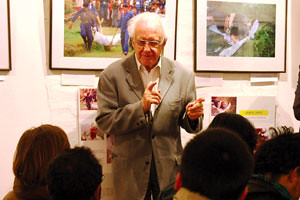Nepal has tried to reconcile with its past without resolving the underlying reasons of the conflict

CINDREY LIU
Ever since the Maoists launched their ‘people’s war’ in the mid-western hills exactly 17 years ago this week, there has been a lot of analysis of why there was a need for a revolution in the first place.
Some saw it as the Maoist party taking a short-cut to power through armed struggle because they lost elections, while others saw the revolution as a true uprising against centuries of entrenched feudalism. Seven years after the end of war, the contest for the definitive narrative is still going on.
Did 16,000 Nepalis have to die because Pushpa Kamal Dahal and his dogmatic comrades wanted to establish a communist dictatorship, or was it a legitimate struggle to counter the structural violence of the state and establish a more just and equal society?
War cannot be justified even in retrospect of the achievements it claims, but what tends to get glossed over today is the state’s lack of response to the inequities and injustice that was at the root of Nepal’s conflict. The tales of discrimination against the Dalits, women, Muslims, Madhesis by a monolithic Hindu monarchical state that preceded the conflict have been deliberately air brushed from today’s narratives.
Earlier this week, on the eve of 17th anniversary of the start of the conflict, noted Norwegian peace studies professor
Johan Galtung gave a stark warning during a talk at the Peace Museum in Patan: Nepali society will be in perpetual conflict if Kathmandu’s elite continues to betray people’s aspirations for genuine structural change in society (pic, above).
Often in post-revolution phases, the elite is scared of retribution from the bottom rung and resists change, Galtung said. So to ensure a peaceful transition, it is better to lift those at the bottom without disturbing those at the top. This was a generic prescription Galtung has been giving out from South Africa to South America, and fails to take into account Nepal’s unique political power balance where the progressive middle is squeezed by extremists on both sides of the political spectrum who dominate the discourse.
One of the contested provisions of the peace process is post-conflict truth and reconciliation. The prevalent narrative portrays the conflict as mindless killing with no socio-economic or political rationale. However, the cold blooded murder of
Muktinath Adhikari by the Maoists in 2002 and the torture and killing of
Maina Sunuwar by the Nepal Army in 2004 were both manifestations and by-products of the same unjust political structure. Those who killed Adhikari were also citizens of this land and their action speaks of the psyche of society as a whole. Similarly, the torture and rape of fellow citizens by soldiers exposed how dehumanised state security forces had become.
“We know punishing those who took away our loved ones will not bring them back, but the least they could do was confess and tell us the truth. It is equally disappointing that those claiming to speak on our behalf have used our cause for their own ends,”
Ram Kumar Bhandari, whose father Tej Bahadur Bhandari was disappeared by the army in Lamjung in 2001, told me after the Galtung talk. Bhandari now leads a network of families whose members were disappeared by both the Maoists and Nepal Army.
In the name of peace, many in Nepal have been trying to work towards reconciliation without resolving the underlying and unaddressed reasons for the conflict. It is now clear that the Constituent Assembly was dissolved last year because traditional forces across political parties, sections of the mainstream media, and the civil society feared changes that would come with a secular and federal Nepal. The longer the excluded are kept at the margins, the potential for conflict will always be there.
History has always privileged the powerful, but it has also given the oppressed the right to protest. Nepal’s political future hangs uncertainly waiting for a resolution between the two. When that happens, reconciliation will take care of itself.